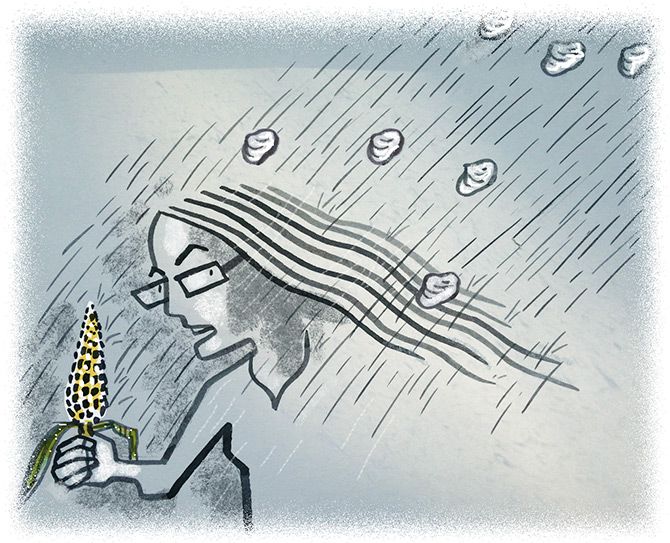While everyone raves about the joys of the monsoon, Keya Sarkar is not as enthusiastic.
Illustration: Dominic Xavier/Rediff.com

The monsoons in Santiniketan can be a little trying.
While many friends and acquaintances love coming here to see the rain amidst the green, I cannot share their enthusiasm.
That is probably because I stay in a house built 70 years ago by my maternal grandfather.
While, the year round, I enjoy the pleasure of living in a 'heritage villa' as friends call it, in the monsoons the heritage is a liability. The walls get damp.
We are to blame for our plight because we have chosen to paint the outside of the house with a traditional lime wash instead of the industrial 'weather coat' and the insides with layers of gobar (from before the Bharatiya Janata Party came to power) and then white clay.
All the time that my father was alive, he would tell me that I was being stupid in adopting traditional methods. I understood his anxiety (he had worked for Berger Paints for the better part of his career) but I stuck to my guns.
Of course, every year after the monsoons, we call our contractor and fill up cracks on the roof to lessen the seepage, but I can feel that he, too, is getting increasingly frustrated, having already applied all the tools in his trade to arrest the damage.
Added to this is the water table rising so much that patches of dampness even show up on the floors.
I am told that the method of building foundations many years ago, coupled with the sandy soil in this area, results in this dampness (I have checked, the same ails many old houses here).
So, unless we demolish the house and reconstruct it, we pretty much have to live with this.
As we have to with all the snakes that surface in the garden and threaten to enter our home.
The logical part of my brain tells me that, with their houses flooded, the poor snakes need to get to drier areas but the emotional part of my brain doesn't really care. I dislike having to study them at close quarters to apprise myself of whether they are poisonous or not.
The part of the monsoons that I like in Santiniketan are the bhuttas (corn cobs).
Available in plenty during the monsoons, they really add a kick to dreary grey-skied evenings.
Not the cloyingly sweet American corn, but the fragrant desi bhutta.
There is one guy, who we go to year after year, and he knows how exactly we like our bhuttas. Young but firm, medium roasted and lightly salted.
He hails from Bihar's Darbhanga district, but moved to Santiniketan in his teens.
We often exchange notes on happenings in Santiniketan and lament together at the falling standards of cleanliness.
Through all this, a street dog chews at the cobs that people throw away. We never fail to be amused at the way the dog holds on to one end of the bhutta with one paw and gets the few kernels remaining with his teeth.
Our man informed us that he had started making momos too.
I was quite horrified at the thought of our man hailing from Bihar dishing out momos.
I asked him whether he knew which part of the country this food comes from. He obviously didn't have a clue but took only a few seconds to respond: "It comes from the same place that all other momos do."
I know it's unreasonable, but strangely that day my bhutta felt adulterated.











